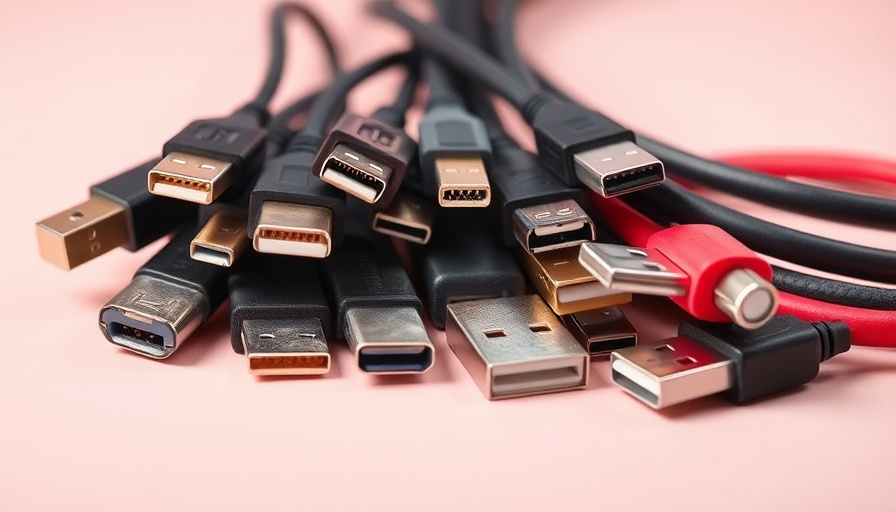
Discovering the USB Cable Landscape
In a world dominated by digital communication, the often-overlooked USB cable plays a crucial role in our everyday tech connectivity. Understanding the different types of USB cables available—like USB-A, Micro-USB, USB-C, Mini-USB, and Lightning—can empower you to make informed choices about your devices. Each type has its unique characteristics, potential uses, and limitations, making clarity around them essential.
USB-A: The Old Faithful
USB-A has long been the standard connector found on older laptops, TVs, and a multitude of peripherals. Its rectangular shape makes it easily identifiable, yet it’s not reversible, which often leads to users fumbling to find the right orientation. Relying heavily on this type might feel nostalgic, but be cautious; as USB technology evolves, USB-A is slowly fading out for more advanced connectors. Depending on its version, USB-A can support speeds from 480 Mbps (USB 2.0) to higher rates in USB 3.0 and above.
Micro-USB: The Small Wonder
Once the default connector for many Android devices, the Micro-USB is smaller than its predecessor and features a distinctive trapezoidal shape. While convenient, the Micro-USB can present durability issues due to its internal pins, which may wear out with regular use. Understanding that Micro-USB usually only supports USB 2.0 speeds can guide you in making better purchasing decisions for newer technology.
USB-C: The Future is Here
USB-C is undeniably the game changer in the USB world—tiny, oval, and reversible, it has become the go-to choice for modern gadgets. This sleek connector manages charging, data transfer, audio, and video with unparalleled efficiency, catering to everything from smartphones to laptops. Some USB-C cables support astonishing data rates of up to 40 Gbps, especially when utilizing the latest USB4 or Thunderbolt 4 specifications. However, it’s vital to scrutinize the specifications of USB-C cables before buying, as not all of them deliver the same capabilities.
Mini-USB: The Nostalgic Choice
Mini-USB may remind you of early digital cameras and MP3 players. Though a bit bulkier than Micro-USB, it’s largely obsolete and doesn't support any speeds beyond USB 2.0. If you happen to possess devices that still use the Mini-USB, it’s wise to hold onto those cables, as replacements are becoming increasingly scarce.
Lightning Cables: Apple’s Exclusive Connector
Lightning cables hold a special place in Apple’s ecosystem—they are the exclusive connectors for iPhones and other Apple devices. Slim and reversible, they provide decent charging and data transfer capabilities. However, it's worth noting that Lightning doesn’t match the high-speed potential of USB-C, particularly as Apple transitions newer devices to USB-C. If affordability is a concern, be prepared for the comparatively higher prices of Lightning cords due to their proprietary nature.
Why Understanding USB Types Matters
Understanding the differences between USB cables can help consumers make significant decisions about their technology use. Choosing the right cable not only optimizes device performance but can also minimize frustrations associated with compatibility and compatibility issues. Homeowners and tech enthusiasts can streamline their tech experiences by ditching outdated adapters, ensuring that they have the most efficient connections available.
Future Predictions: Where USB Technology is Headed
As advancements continue in charge speeds and data transmission, USB technology will likely evolve to be even more robust and versatile. With USB-C taking center stage, it may well become the universal standard, leaving outdated connectors behind. However, as tech improves, manufacturers must also remain cognizant of building quality and durability into their cables to ensure longevity for consumers.
Final Thoughts: Empower Yourself with Knowledge
The realm of connectors might feel overwhelming at first, but fostering a clear understanding of USB cables can simplify your tech life. By recognizing the strengths and weaknesses of each type, you can arm yourself with the knowledge to make wiser purchases—whether it’s a new phone, gaming console, or charging station. Don't let confusion keep you tethered to outdated technology; take this knowledge and transform your tech experience today!
 Add Row
Add Row  Add
Add 




Write A Comment